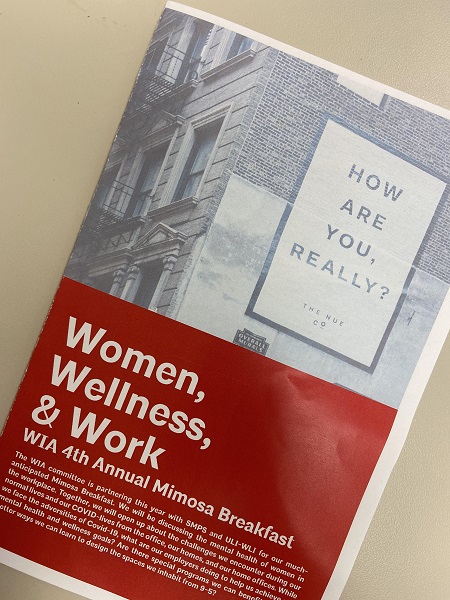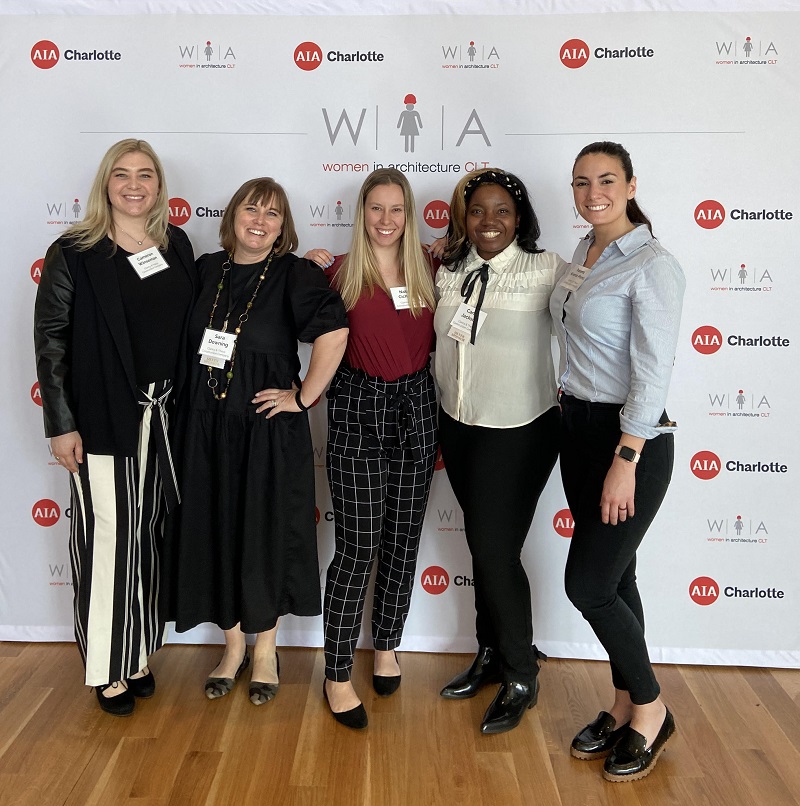
Women, Wellness and Work: AEC Professionals in Charlotte Come Together for Annual Women in Architecture Event
Women, Wellness, and Work: the theme of the Fourth Annual AIA Charlotte’s Women in Architecture (WIA) Mimosa Breakfast in April centered on these ideas that have become so prevalent in the architecture, engineering, and construction (AEC) industry. This fantastic networking and learning event, hosted in partnership with the Society for Marketing Professional Services (SMPS Charlotte) and Urban Land Institute (ULI Charlotte) Women Leadership Initiative, gave professional women in the Charlotte area an opportunity to celebrate what it means to work in the AEC industry.
The presenting panel included Sarah Francis, the Director of Planning, Design, and Construction at Atrium Health; Vickie Breemes, National Director of Advanced Building Technologies at Little Architecture; and Jennifer Sulak Brown, Sr. Vice President of People + Culture + Brand at Barton Malow Builders. The panel was moderated by WBTV news anchor and author, Molly Grantham.

The morning started with a question that we often ask and answer multiple times a day: “How are you?” This question is typically answered with a “fine” or “good” even though there may be a fire burning inside our heads, spinning with all the things on our to-do list. What if instead of asking “How are you?” we asked, “How are you, really?” And what would it look like if we answered with our authentic, vulnerable selves? Perhaps the answers would be hopeful, excited, overwhelmed, tired or a myriad of other adjectives that truly represent our mental states.
We all are juggling a lot. How do we have a work-life balance or, perhaps more realistically, work-life integration? How do we juggle it all? This challenge presents itself to us uniquely as women. Women are often caregivers for children and aging parents, which adds so much more stress to our lives. Flexibility is vital, and having the support of a boss, team and organization are imperative for success. In response to this juggling act, women are making a change. While statistics show that during the pandemic more women left the workplace than their male counterparts, more women also changed jobs in search of a role in a more supportive, more flexible environment.
These flexible environments that have come about in response to the “Great Resignation” aren’t limited to the decision between working from home, the office, or both. The flexibility is being reflected in the design of new office spaces. As employees return to work, some after two years at home, wellness has become central to office design. Employees are accustomed to taking calls while walking around the block, engaging in video calls with their teams from the couch, or going to their home offices for quiet head-down time. The same thing is desired in the workplace. Companies are renovating existing office spaces to allow for more collaboration spaces as well as comfortable areas. Designs include couches, outdoor spaces, and secluded rooms for meditation or quiet time. Designers are seeing WELL principles and certifications being discussed with clients more than ever before.
Sarah Francis from Atrium Health noted that the wellness of employees is trickling down to the clinical space. While hospitals are still designed with the patients in mind, the health and wellness of the doctors and nurses is also important. Giving access to quiet rooms to get away from the noise and stress, providing access to outdoor spaces separate from hospital entryways, and ensuring natural lighting is integrated into interior spaces are some of the employee wellness considerations being mirrored in the designs of healthcare settings.
The consideration for employee wellness requires buy-in at all levels of the corporate structure. As companies have embraced the flexible work model and have teams working in the office and remotely, it is critical that leaders are conscious of their bias towards those who come into the office versus those working remotely. Employees who are working remotely need to be visible and need to be part of the culture. As a remote employee, it is essential to speak up for yourself and to keep track of successes to discuss during review time. As a manager of a remote team, it is important to offer remote workers visibility by assigning high profile projects to those individuals.
Finally, the last few years have taken a toll on many, and mental health is becoming more widely discussed in the workplace. Most companies have employee assistance programs and anyone who needs assistance should take advantage of such benefits. As we all go back to work and as everyone is adjusting to the “new normal,” I encourage you to authentically ask how people are doing and really listen. Sometimes having someone to listen is all that is needed.
So take a deep breath and exhale slowly. As we are all adjusting and we are all juggling, reach out and ask, “How are you, really?”
About the Author – Sara Downing is Director of Business Development for Clancy & Theys Construction Company. Founded more than 70 years ago in Raleigh, NC, the company remains headquartered there with additional offices in Charlotte and Wilmington, NC; Newport News, VA; and Orlando, FL.
Main Photo – Clancy & Theys Construction team (L) to (R) Cameron Winseman, Sara Downing, Natalia Cichocka, Carla Jackson and Paloma Alvarez-Perez.






